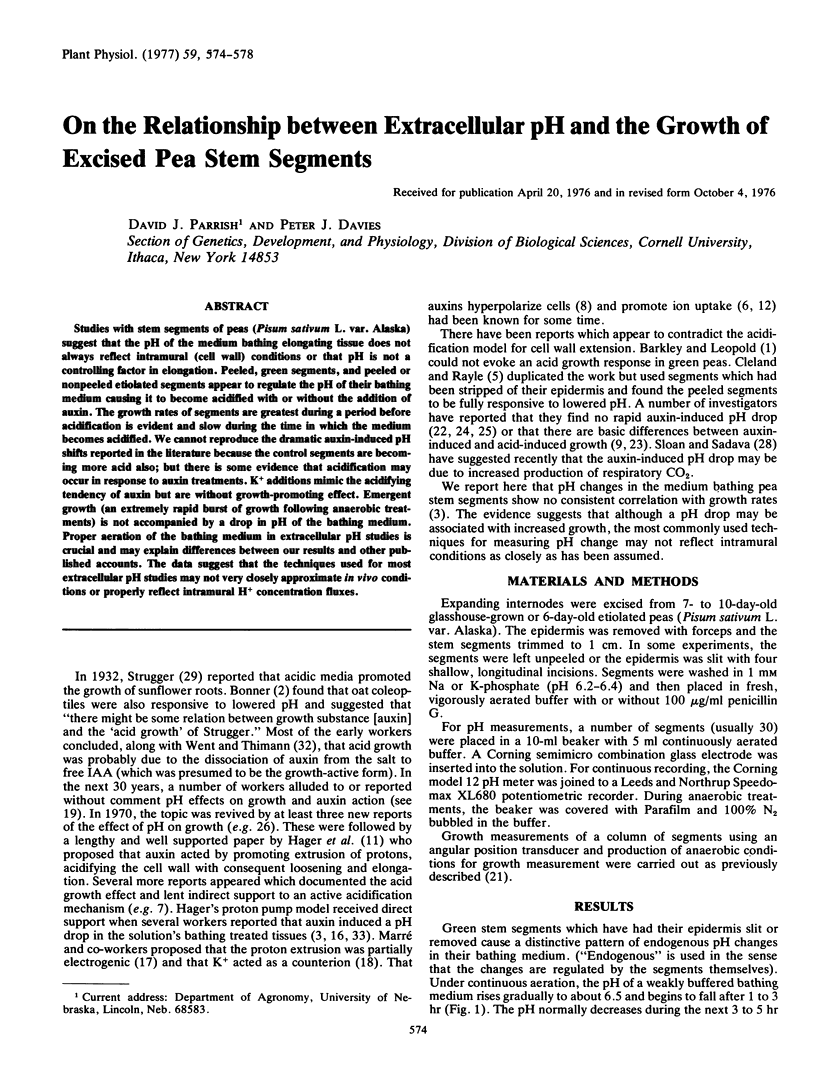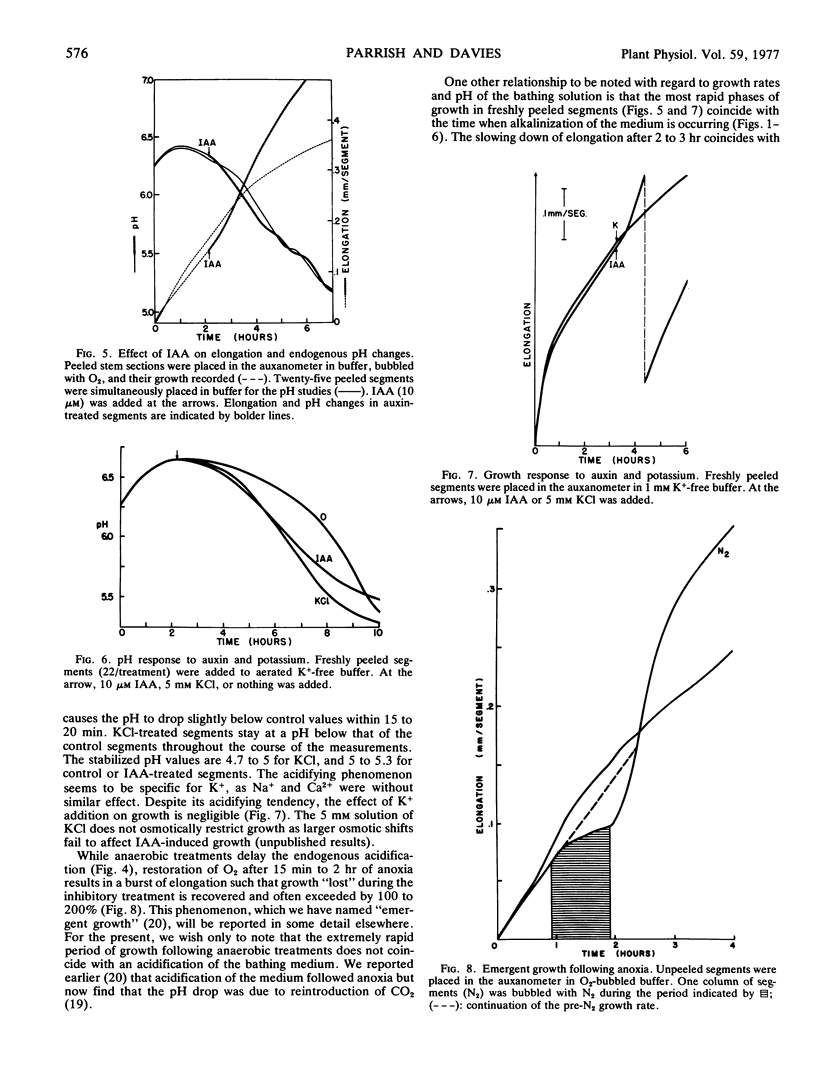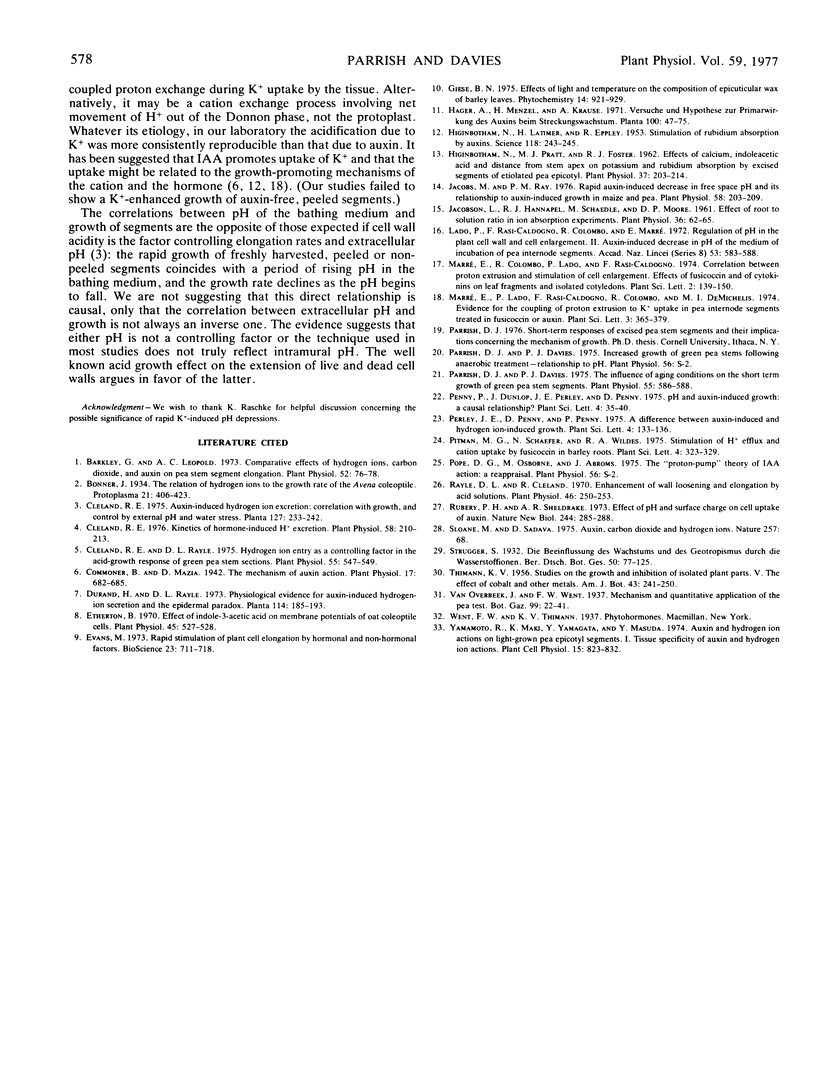Abstract
Studies with stem segments of peas (Pisum sativum L. var. Alaska) suggest that the pH of the medium bathing elongating tissue does not always reflect intramural (cell wall) conditions or that pH is not a controlling factor in elongation. Peeled, green segments, and peeled or nonpeeled etiolated segments appear to regulate the pH of their bathing medium causing it to become acidified with or without the addition of auxin. The growth rates of segments are greatest during a period before acidification is evident and slow during the time in which the medium becomes acidified. We cannot reproduce the dramatic auxin-induced pH shifts reported in the literature because the control segments are becoming more acid also; but there is some evidence that acidification may occur in response to auxin treatments. K+ additions mimic the acidifying tendency of auxin but are without growth-promoting effect. Emergent growth (an extremely rapid burst of growth following anaerobic treatments) is not accompanied by a drop in pH of the bathing medium. Proper aeration of the bathing medium in extracellular pH studies is crucial and may explain differences between our results and other published accounts. The data suggest that the techniques used for most extracellular pH studies may not very closely approximate in vivo conditions or properly reflect intramural H+ concentration fluxes.
Full text
PDF




Selected References
These references are in PubMed. This may not be the complete list of references from this article.
- Barkley G. M., Leopold A. C. Comparative effects of hydrogen ions, carbon dioxide, and auxin on pea stem segment elongation. Plant Physiol. 1973 Jul;52(1):76–78. doi: 10.1104/pp.52.1.76. [DOI] [PMC free article] [PubMed] [Google Scholar]
- Cleland R. E. Hydrogen Ion Entry as a Controlling Factor in the Acid-growth Response of Green Pea Stem Sections. Plant Physiol. 1975 Mar;55(3):547–549. doi: 10.1104/pp.55.3.547. [DOI] [PMC free article] [PubMed] [Google Scholar]
- Cleland R. E. Kinetics of Hormone-induced H Excretion. Plant Physiol. 1976 Aug;58(2):210–213. doi: 10.1104/pp.58.2.210. [DOI] [PMC free article] [PubMed] [Google Scholar]
- Commoner B., Mazia D. THE MECHANISM OF AUXIN ACTION. Plant Physiol. 1942 Oct;17(4):682–685. doi: 10.1104/pp.17.4.682. [DOI] [PMC free article] [PubMed] [Google Scholar]
- Etherton B. Effect of Indole-3-acetic Acid on Membrane Potentials of Oat Coleoptile Cells. Plant Physiol. 1970 Apr;45(4):527–528. doi: 10.1104/pp.45.4.527. [DOI] [PMC free article] [PubMed] [Google Scholar]
- HIGINBOTHAM N., LATIMER H., EPPLEY R. Stimulation of rubidium absorption by auxins. Science. 1953 Aug 28;118(3061):243–245. doi: 10.1126/science.118.3061.243. [DOI] [PubMed] [Google Scholar]
- Higinbotham N., Pratt M. J., Foster R. J. Effects of Calcium, Indoleacetic Acid & Distance From Stem Apex on Potassium & Rubidium Absorption by Excised Segments of Etiolated Pea Epicotyl. Plant Physiol. 1962 Mar;37(2):203–214. doi: 10.1104/pp.37.2.203. [DOI] [PMC free article] [PubMed] [Google Scholar]
- Jacobs M., Ray P. M. Rapid Auxin-induced Decrease in Free Space pH and Its Relationship to Auxin-induced Growth in Maize and Pea. Plant Physiol. 1976 Aug;58(2):203–209. doi: 10.1104/pp.58.2.203. [DOI] [PMC free article] [PubMed] [Google Scholar]
- Jacobson L., Hannapel R. J., Schaedle M., Moore D. P. Effect of root to solution ratio in ion absorption experiments. Plant Physiol. 1961 Jan;36(1):62–65. doi: 10.1104/pp.36.1.62. [DOI] [PMC free article] [PubMed] [Google Scholar]
- Parrish D. J., Davies P. J. The influence of aging conditions on the short term growth of green pea stem segments. Plant Physiol. 1975 Mar;55(3):586–588. doi: 10.1104/pp.55.3.586. [DOI] [PMC free article] [PubMed] [Google Scholar]
- Rayle D. L., Cleland R. Enhancement of wall loosening and elongation by Acid solutions. Plant Physiol. 1970 Aug;46(2):250–253. doi: 10.1104/pp.46.2.250. [DOI] [PMC free article] [PubMed] [Google Scholar]
- Rubery P. H., Sheldrake A. R. Effect of pH and surface charge on cell uptake of auxin. Nat New Biol. 1973 Aug 29;244(139):285–288. doi: 10.1038/newbio244285a0. [DOI] [PubMed] [Google Scholar]


